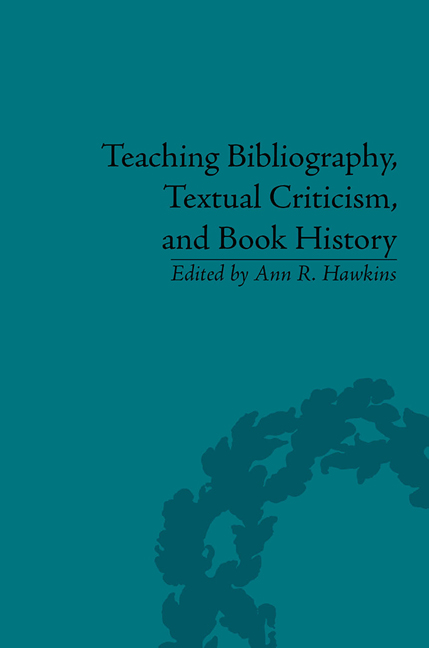Book contents
- Frontmatter
- Contents
- Notes on Contributors
- Foreword
- Introduction: Towards a pedagogy of Bibliography
- Part I Rationales
- Part II Creating and Using Resources
- Part III Methodologies
- Teaching ‘History of the Book’
- Preparing library school graduate students for Rare Book and Special Collections jobs: Assignments and Exercised that Work
- Book History and Library Education in the Twenty-first Century
- Making the Medicine Go Down: Baggy Monsters and Book History
- ‘They are Not Just Big, Dusty Novels’: Teaching Hard Times within the Context of Household Words
- ‘In a Bibleistic Way’: Teaching Nineteenth-Century American Poetry Through Book and Periodical Studies
- Teaching Bibliography and Research Methods
- Teaching Textual Criticism
- Part V Resources
- Index
‘In a Bibleistic Way’: Teaching Nineteenth-Century American Poetry Through Book and Periodical Studies
from Teaching ‘History of the Book’
- Frontmatter
- Contents
- Notes on Contributors
- Foreword
- Introduction: Towards a pedagogy of Bibliography
- Part I Rationales
- Part II Creating and Using Resources
- Part III Methodologies
- Teaching ‘History of the Book’
- Preparing library school graduate students for Rare Book and Special Collections jobs: Assignments and Exercised that Work
- Book History and Library Education in the Twenty-first Century
- Making the Medicine Go Down: Baggy Monsters and Book History
- ‘They are Not Just Big, Dusty Novels’: Teaching Hard Times within the Context of Household Words
- ‘In a Bibleistic Way’: Teaching Nineteenth-Century American Poetry Through Book and Periodical Studies
- Teaching Bibliography and Research Methods
- Teaching Textual Criticism
- Part V Resources
- Index
Summary
Bringing students into the conversation about the value of material book history opens up exciting critical possibilities for literary questioning. From the mechanical (using the history of the book as manufactured object to capture the attention of engineering and technical majors) to the more abstract (invoking the ways book history forces a nuanced analysis of the politics of canonization, or the ways it highlights the differences between reader–response criticism and formalist analysis), a book history context spurs questions I define as distinctly literary, questions addressing ideas about representations, language, and sign systems of meaning.
In particular, book history has a special relationship to poetry: it is a history that calls into question the very concept of representations and images – best exemplified by the compressed nature of poetry. As we analyze the history, transmission, crafting, and social role of the material text, we necessarily foreground the question of representations. How does the physical ink transform itself into a shape that takes on such immense meaning or how does the physical heft of a literature anthology signify the role of cultural capital for the average undergraduate? How does a page allow (or force) us to make meaning? What do those black squiggly marks we call letters represent to us that inform our understanding of the textual world? Because the issue of representations is always present when analyzing books, using book history – with care – to push students to analyze the role of representation in poetry works beautifully.
- Type
- Chapter
- Information
- Teaching Bibliography, Textual Criticism, and Book History , pp. 102 - 108Publisher: Pickering & ChattoFirst published in: 2014



